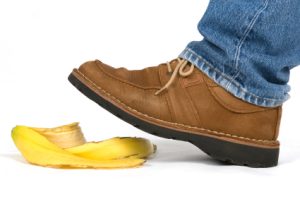Here is a rough summary of your New York slip-or-trip-and-fall lawyer’s tasks:
- Gathering Evidence
The first step in presenting a trip or slip and fall case starts long before trial. It is to gather evidence, including photographs and videos of the accident scene and the specific hazard that caused the fall, witness statements, medical records, and other relevant documents. Measurements of the hazard and the area should also be taken. In slip cases, the weather reports for the area may be crucial.
During the “discovery” phase of the lawsuit, your lawyer is going to need to carefully, thoroughly, and cunningly “depose” the defendant owner or manager as well as any non-party witnesses. The transcripts that result from this questioning will be crucial at trial for “locking in” the witnesses to their prior testimony and for cross-examining them with any inconsistencies.
- Opening Statement
Your personal injury lawyer’s opening statement will be crucial. He or she should methodically present to the jury a summary of the crucial evidence you will present at trial, and explain why that evidence overpowers the defense’s evidence. Essentially, your lawyer is giving the jury a “roadmap” of your case so that they can easily “connect the dots” when they hear the evidence coming in at trial.
- Demonstrating Negligence
Once the opening statements are done, the real fun begins: Presenting the evidence. Negligence is the failure to take reasonable care to prevent harm to others. In a trip or slip and fall case, negligence can be demonstrated by showing that the property owner or manager either affirmatively created the hazard or defect (for example, by leaving debris in a pathway, or digging a hole and failing to cover or mark it property) or did not take reasonable steps to prevent the hazard from forming (for example by (1) failing to maintain the property to prevent the formation of hazards; (2) failing to frequently inspect the property for hazards; (3) failing to fix a broken step or failing to put up warning signs about a wet floor.)
Any or all of this must be systematically, logically, and informatively presented to the jury through witness testimony, using visual exhibits (such as photos, videos, charts, blow-ups of crucial defendant admissions) to overwhelm the jury with airtight evidence.
Cross-examining the defendant’s witnesses is an important part of presenting a trip or slip and fall case. The defendant’s witnesses may attempt to dispute your version of events or to argue that the you are responsible for your own injuries. Cross-examination can be used to discredit the defendant’s witnesses and to demonstrate the strength of your case.
Throughout the trial, your lawyer should have a “theme” or catchy word picture (ex: “If it doesn’t fit, you must acquit”) that will focus the jury on the essence of your case.
- Showing Causation
Besides demonstrating defendant’s negligence, your lawyer must also show “causation”. Causation means that the defendant’s negligence caused your injury. In other words, even if your lawyer proves the defendant negligently created the defect or caused it to exist through neglect, the defendant is not liable unless your lawyer also proves that the hazard is what caused your injuries rather than something else. This may seem obvious, but often, especially with older or disabled plaintiffs, a defense lawyer might try to raise the possibility that the plaintiff tripped over his own feet, or had a tendency to fall, or fell for other reasons. Also, your lawyer will have to prove that your injuries werenot “pre-existing” but were caused by the fall.
- Proving Damages
Finally, it is essential to prove damages. Damages are the injuries and losses you suffered as a result of the accident. In a trip or slip and fall case, damages can include medical bills, lost wages, and pain and suffering. At least one of your treating physicians must be called to the stand to describe your injuries and testify that they were caused by the fall. Your own testimony about the pain and suffering will be crucial, but because you will be clearly seen as biased, it is crucial for your lawyer to also call to the stand non-party witnesses to your pain and suffering: Doctors, physical therapists, family members, co-workers, etc.
5. Closing Argument
The closing argument is the final opportunity for your lawyer to win over the jury. It is essential for your lawyer to prepare a clear and concise closing argument that summarizes the key points of the case. He must look the jury in the eye, not simply read to them. The eye-to-eye connection wins credibility with the jury and delivers a message of sincerity and conviction.
The closing argument should remind the jury of the strongest evidence presented in your favor, and discredit defendant’s evidence. It should also highlight your pain and suffering and other monetary damages.
Your lawyer will also have to suggest to the jury a figure to compensate you. This figure must be carefully considered: Shooting too high might be off-putting to the jury if they feel the number is ridiculous. This might cause them to lose confidence and trust in your lawyer. But the number should always be higher than what your lawyer thinks the jury is likely to give you. Figuring out the right number to ask for is more of an art than a science, which is one of the reasons you want a seasoned attorney who knows how to “read” a jury before presenting them the number.
CONCLUSION
By carefully and methodically gathering evidence and then preparing for, and delivering, evidence at trial, a seasoned personal injury lawyer can maximize your chances of winning, and win more for you.
Keep safe!
Mike Bersani
Email me at: bersani@mbk-law.com I’d love to hear from you!
Michaels Bersani Kalabanka P.C.
Syracuse NY Personal Injury and Malpractice Lawyers
315-253-3293
 Central New York Injury Lawyer Blog
Central New York Injury Lawyer Blog


